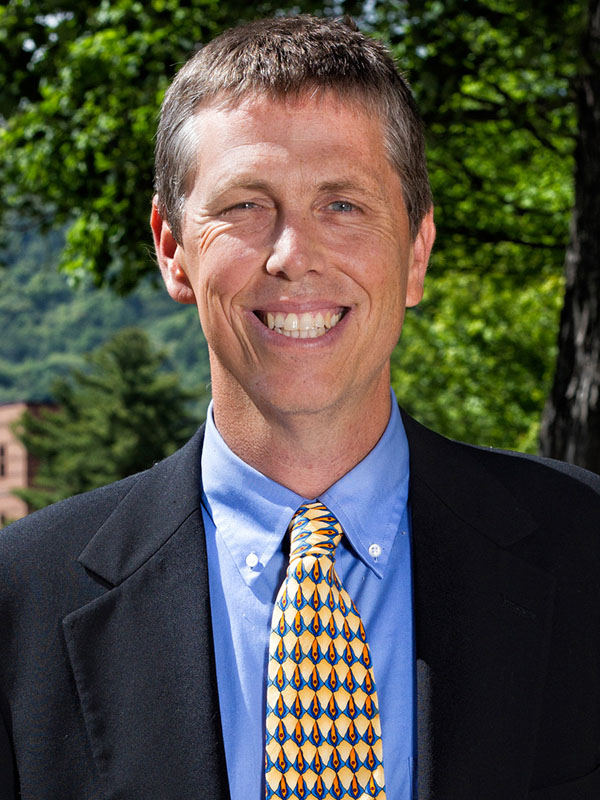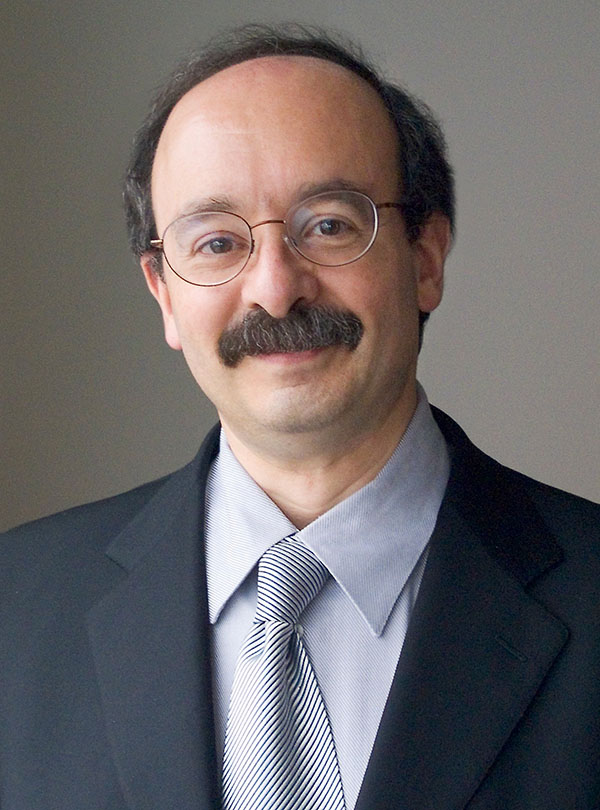
Chief Sustainability Officer
Appalachian State University
On this Find Your Sustain Ability, Appalachian's chief sustainability officer, Dr. Lee F. Ball, welcomes who he calls “one of the country’s foremost leaders in renewable energy and energy efficiency” — Amory Lovins. Lovins is chairman emeritus and chief scientist at the Rocky Mountain Institute (RMI), a nonprofit with a mission to “transform global energy use to create a clean, prosperous and secure low-carbon future.”

Chief Sustainability Officer
Appalachian State University
Transcript
Announcer: Define sustainability. Odds are your definition is completely different from the next person's. Appalachian State University's director of sustainability, Dr. Lee Ball, sits down with his guest to explore the many ways in which sustainability affects our lives. This is Find Your Sustain Ability.
Lee Ball: Welcome everyone. My name is Lee Ball and I am your host of Find Your Sustain Ability. I recently had the opportunity to sit down with The Rocky Mountain Institute's chief scientist Amory Lovins. We've had the pleasure of knowing Amory Lovins for the past eight years through our relationship with The Rocky mountain Institute. Amory Lovins is one of the country's foremost leaders in renewable energy and energy efficiency. We sat down with him to talk about potential challenges and solutions in renewable energy and I hope you enjoy the podcast.
LB: So we're here today with Amory Lovins. Amory, thank you so much for taking your time to come to Appalachia State and to join me on my podcast that we call Find Your Sustain Ability.
Amory Lovins: Nice title. Thanks for having me.
LB: So what's keeping you busy these days? Are you still traveling a lot?
AL: Yeah. I'm just back from almost a month travel in East Asia and West Asia. And working on some interesting bits of research. One is on how to save most of the cement and steel and other energy-intensive materials we use. And another's how to make an integrative design the general practice instead of rare. That means you're designing buildings, vehicles, factories, as whole systems rather than as a pile of parts. And if you make the parts work together rather than against each other, you get several fold bigger energy savings at a lot lower cost. So I'd like to make that come out of the water faucets.
LB: So that reminds me of what Wendell Berry used to call solving for pattern.
AL: Mm-hmm (affirmative). Same idea. And in fact, I love Wendell and his work. And I use that concept all the time. If I want to help you design a car better, I might talk about my house, where I grow bananas up in the Rockies, down to minus 47 F with no furnace. But it's cheaper to build that way because I save more construction cost leaving out the heating system than I pay extra for the stuff that gets rid of the heating system.
AL: So if you wanted to design a really good car, we take out a lot of weight and then you need less propulsion system to haul it around. And that gets cheaper and pays for the lightweighting. In fact, I a car that does that, it's a carbon fiber electric car. And people thought carbon fiber costs too much, but guess what? It's paid for by needing fewer batteries. And then they recharge faster and everything gets better.
LB: So Amory, you've often mentioned that we have, a lot of the technologies that we need, you refer to them as off-the-shelf technologies. Can you speak a little bit about that?
AL: Yeah. The technologies we had in 2010 were enough to save three quarters of our electricity at about a 10th the cost we pay for it. Most of the rest of the energy we use, a lot cheaper than buying it. And that technology keeps improving. Although actually what's improving even faster is design, the way we choose and combine technologies.
AL: So give you a little example from big office buildings. In 2010, when we led the retrofit of the Empire State Building, we saved 38% of the energy. They'd already saved some. And that paid for itself in three years and that was thought pretty good at the time. But then three years later, in a big federal complex in Denver, we saved 70% cost effectively and made that half-century-old difficult building more efficient than what was then the best new office in the country. Which in turn is only half as efficient as our new office. And now there's a German building using three fifths less energy than ours. This isn't because a lot of whizzbang new technologies got invented. It's because we got better at picking which ones to use and how to put them together in what order and matter and proportions, like a good recipe.
LB: So integrated design played a strong role in that, I assume?
AL: Yes. And it's starting to get pretty widely known that you can do that with buildings of all kinds. What is not so obvious is you can do the same thing in vehicles like my 124 mile-a-gallon equivalent car. Or in industry where we get much bigger, cheaper savings than other practitioners. And part of that is because we're redesigning the process and equipment in a holistic way.
AL: We're not just looking at the different parts of it separately. Part also is because we're picking up some big savings that had been overlooked. For example, three fifths of the world's electricity runs motors. They're mainly in industry, the rest in buildings. And half the motor power is to run pumps and fans, to move things like air and water around through pipes and ducts.
AL: Now it turns out if you make the pipes and ducts, which people hadn't paid that much attention to, fat, short, and straight, rather than the normal skinny, long, and crooked, you can cut the friction 80 or 90%. Therefore the energy used by the fans and pumps and the size of the fans and pumps and the motors that run them. And that makes the capital cost lower. But the energy savings are so big that if everybody did this around the world, hypothetically, you would save about a fifth of the world's electricity. That's half the coal fired electricity.
AL: And we find an industry, you typically get your money back by doing this in less than a year if you're fixing up an old factory or instantly if you're making a new one. So why isn't this generally done? Well, for starters, it's not in any engineering textbook, with a tiny exception from our buddies in Australia. It's not in any government study, industry forecast, climate model. Why not? Because it's not a technology, it's a design method. And people don't normally think of design as a way to make things go big, fast.
LB: Yeah, I'm intrigued by the gestalt theory that talks about the sum of the parts being greater than the whole.
AL: Aristotle said that a long time ago.
LB: Yeah, and that, the greater part really intrigues me. I just spent the last, I spent three days this week with Janine Benyus from Biomimicry 3.8 and she said to say hello, by the way.
AL: Lucky you.
LB: I've told her that I was going to be with you. And we were focusing on the notion of generous design. Her work is really trying to figure out how, through design like you were just mentioning, we can be generous and abundant with the built environment. What are your thoughts on that?
AL: Well, as usual, she's absolutely on target. Buildings ought to create delight when entered and satisfaction, health, happiness, productivity when occupied. Regret when departed. They ought to look like they grew there. They ought to, Dre Anderson said, "Take nothing, waste nothing, do no harm." And we're figuring out how to do this by losing some old ideas. That's the hard part. So you can have new ideas to go in their place.
AL: Of course a lot of traditional architecture already did all this. We just forgot and we got too specialized. We chopped it up so that it wasn't all in one head anymore. Now we even have different architects for the inside and outside of the building. And then a gaggle of engineers and specialists each doing one little part of it. So of course they don't work together properly.
AL: But as we learn to put the parts back together again into an integrated whole, guess what? The building gets a lot better and simpler and cheaper and works better. Once you're in it, it's kind of like magic. You instantly realize you're in a different kind of building that you'd normally have to endure.
LB: I felt like that when I was at your headquarters in Colorado.
AL: Yeah. Wandering through the banana jungle.
LB: Right, right, and in your house.
AL: Yeah, we're on crop 76 right now. And I got guavas coming out and we're about to harvest some limes and babacos.
LB: I mean your house, especially, is an example of just off-the-shelf technology.
AL: Yeah, a 1983 state of the shelf. Although we've improved windows and other things some more since then as they evolve. Yeah, there's nothing exotic in there. What's more important is what we left out. Furnace, ducts, fans, pipes, pumps, wires, controls, fuel supply arrangements. We don't burn stuff. That's so 20th century.
LB: So let me ask you a question about the electrification of all things. Are you finding that we're making some headway or are we going in the right direction?
AL: Yes. Although it's not quite all things. There's a lot of industrial heat, for example, that will work better with direct renewable heat. And also don't forget about hydrogen. And maybe for marine shipping, ammonia is a good alternative fuel as well with no carbon. And you can make the hydrogen out of renewable electricity now that it's getting so ridiculously cheap. So you don't need to reform it from natural gas and put carbon in the air.
AL: But most functions should be indeed electrified. That's going well. And in fact, Britain and Holland, both of which had big conversions to natural gas decades ago when they discovered a bunch off shore there, they're now going back the other way and switching off natural gas. Berkeley was just the first city in the US to stop new gas hookups and say we're going to convert off gas.
AL: It's good for a lot of reasons to do that. Indoor air quality, safety, public health, especially as our old infrastructure deteriorates. And also climate. And it's not just burning the gas but all the methane that dribbles out all the way from the wellhead to the pipes in your walls that we're never going to tear the walls apart to get at and fix.
AL: And in fact, I was just with one of the ministers in an Asian country who said, "In our country, we got really rugged topography. And when we build houses like this 5 million new house program we're just starting, it's very expensive to run that gas pipe over all this rough country alongside the electricity. If you're saying we can make the buildings really efficient so it's economical and attractive to do it with just electricity and maybe make that right on the roof, heck, we can stop piping the gas, save a whole lot of money and put that into paying for the efficiency." That's a great idea.
LB: So speaking of efficiency, I mean those of us that have been studying building science and the built environment realize the importance of energy efficiency. Again, off-the-shelf technology, improving technologies, or making it easier and easier for us to save energy in our wall systems and floor system and roof systems. Why do you think that we are still, after all these years, challenged with barriers to people accepting that it's wise and prudent to make deep investments in energy efficiency?
AL: Force of habit. Probably not having experienced what a great building can be. A lot of people find it more comfortable just to do what they're good at and have done for a long time rather than doing something different. There's a lot of human nature like that. But our species is also got where it is by adapting to new needs, taking up new challenges, having new ideas, getting rid of some old ideas that served us well but they're not right anymore.
AL: And the word is spreading. And I think market competition will do a lot of that job for us. I remember when people started building early super insulated and often passive solar houses in cold places like say Montana. It seemed a pretty weird idea until one developer said, "You buy my house, I'll pay the utilities the first five years, no questions asked." And he soon had a waiting list from three counties away.
AL: There's a developer in Palatine, Illinois, Perry Bigelow, who built roughly a thousand tight and well insulated, ordinary stick built houses. And every year, if you send him your utility bills, you'd be entered in a drawing to get a free vacation in the islands in the winter. But he would then go over the bills and whoever had the lowest bills would get a prize of some value. And his deal was that, depending on how big your house was, he would cap your energy bills at 50 or a hundred or $200 a year. And he only had to pay up twice when somebody probably left the door open all winter or something like that.
AL: And his houses sold very well and people were delighted with them. Well of course now there's hundreds of thousands of passive houses in Europe. It's spreading all over the world, including the US. They are so much healthier and nicer to be in. There's no drafts. You'll always feel comfortable. And you don't really care if the electric or gas system outside fails because your house will work normally anyway.
LB: It seems like we've become complacent and almost comfortable being uncomfortable in the built environment and just assume that that's the way it always has been and the way it is inside of our buildings.
AL: Well. That's why it's quite a eyeopener for people to experience a good building and why it's important for anybody that doesn't know why this is a wonderful opportunity for them and for this whole society to go visit some great buildings. First 10 years we were in our banana farm near Aspen, we had over 100,000 visitors and we probably had about as many against since then.
LB: Wow. So you often talk about beginner's mind, and I'm always fascinated to hear you speak about beginner's mind and what that is and the advantages of it. Can you speak to that a little bit?
AL: Yeah. There's a long tradition in many Asian cultures about don't forget original mind. Sometimes it's called child mind, beginner's mind, and it's a state in which you're not captive to your assumptions and preconceptions. It's like a clean slate and you can actually see what is and have new ideas without there having to displace old ones first.
AL: There's a famous old story about this, about a Zen master named Nanin who received one day and imperious visitor, accounts differ whether it was a businessman or a government official, who insisted on being taught Zen. So Nanin smiled and poured tea and kept pouring, and kept pouring, and the tea overflowed the cup and spilled on the table and onto the visitors robes. The visitor got quite agitated. He said, "Stop, stop. Don't you see it's full? No more will go in." And Nanin stopped pouring and said, "Well, you come here wanting to learn Zen. How can you learn unless you have first emptied your cup?"
LB: Awesome. That's great. So I've noticed that you, when we visited RMI in Basalt, you had a lot of millennials and young people working on your team. Is that one of the reasons? Having that beginner mind? Less experience?
AL: Yeah. But wonderful talent. We're so blessed with the people that we've managed to attract. Many are young, with all of the advantages of not knowing too much about how things are supposed to be done. And they often have wonderfully original ideas. So I think that's one of the keys to our success.
LB: but we can cultivate that, too, no matter how old we are, right?
AL: Yep.
LB: Just by studying a new discipline or topic that we're not familiar with.
AL: Mm-hmm (affirmative). And being quite disciplined about asking as you learn something new, okay, how does that fit with what I thought I knew? Is it contradicting something that now it's time to lay to rest and go with the new better understanding? Also, we tend to be unduly influenced by these artificial boundaries and barriers that come out of academic tribalism.
AL: I dropped out of two great universities that wanted me to specialize too much. And the specialization of course was in academic departments, but in disciplines and categories that are artificial. They don't really exist. Knowledge is seamless and boundless and boundaryless. So I encourage students to jump the fences, walk on the grass, learn anything you think you need. And if your advisor raises eyebrows looking at your course of study and says, "I don't see how this relates to that," you're probably on the right track.
AL: And I think, well, if you want to read more about that, you can search online for an article called Wonder in the Bewilderness, which is a little essay I did for Harvard Magazine. That's one of the places I dropped out of. And they asked Bill Gates and me and one other dropout and seven graduates what were our hopes for this university when it got to be 400 years old?
AL: And my hope was that anybody, at any level, anywhere in the university, could study anything they want. After all, it's a university, isn't it? Well, the administrators didn't see it that way. And in my time, would have been class of '64, that's 1964, they said, "Well, we can't really let you study anything you want because most of the time when we've let people do that, it's worked out badly. So we have to protect you from your exuberantly transdisciplinary impulses." I said, "I don't see why. It's my time and my money. They're both scarce resources. I'm willing to take the risk. Why won't you let me do that?" And they weren't very helpful. So I left for Oxford.
LB: Well we've been imagining how to create such an environment here that is truly transdisciplinary and collaborative in nature. Some of us are calling it The Unsiloed Project, really to be incentivized also to work together.
AL: Yeah, well, Lee, this was popping up in a lot more places. I ran into the president recently of a Midwestern liberal arts college and his dream is that one day, a nice sunny day, he calls all the faculty out onto the big lawn in front of the academic buildings and says, "As of this moment, your departments are abolished. Mix, talk to each other, and figure out stuff you have juice for doing together. And I'll be sitting here. And when you have a team together, come on up and we'll write down who's on your team and what you want to do together. And the more departments you come from, the higher priority I'm going to give you at budget time."
LB: Brilliant.
AL: I don't know if he's done it yet, but I thought it was a really neat idea.
LB: Very, very, very great idea. I would love to do the same thing here. Let me ask you one more question because I know you're busy and we've got a big day ahead of us. What are you excited about in your work that really gives you hope for the future?
AL: Well I do live and work in a spirit we call applied hope, which is not mere theoretical hope or glandular optimism because it comes from doing each day what it takes to create a world that's worth being hopeful about. If you want to know about that, go to rmi.org, search on Berkeley, and you'll find my talk on applied hope for commencement.
AL: I am interested in a lot of things, as you may gather. But I think the next big thing I want to really make happen is integrative design. Because it makes energy efficiency as a resource several fold bigger and cheaper than had been thought and often gives it increasing returns. Just like modern renewable energy, the more you buy, the cheaper it gets so you buy more so it gets cheaper. And that makes it a runaway winner. Of course, there are many important things to do besides energy efficiency, but that's kind of a master key to many, many other problems in the world. And it has analogies in water efficiency and many other kinds of efficiency. Just bringing more work out of the resources we have so we can take less, waste less, pay less, and live better.
LB: Great. Well, Amory Lovins, thank you so much for joining me on today's podcast. We look forward to hearing your remarks during the Appalachia Energy Summit this evening. And that's a wrap.
AL: Thank you.
What do you think?
Share your feedback on this story.
About Sustainability and Energy Management at App State
Appalachian State University’s leadership in sustainability is known nationally. The university’s holistic, three-branched approach considers sustainability economically, environmentally and equitably in relationship to the planet’s co-inhabitants. The university is an active steward of the state’s interconnected financial, cultural and natural resources and challenges students and others think critically and creatively about sustainability and what it means from the smallest individual action to the most broad-based applications. The university offers both undergraduate and graduate academic degree programs that focus on sustainability. In addition, 100 percent of Appalachian’s academic departments offer at least one sustainability course or course that includes sustainability, and all students graduate from programs that have adopted at least one sustainability learning outcome. Learn more at https://appstate.edu/sustainability.
About Appalachian State University
As a premier public institution, Appalachian State University prepares students to lead purposeful lives. App State is one of 17 campuses in the University of North Carolina System, with a national reputation for innovative teaching and opening access to a high-quality, cost-effective education. The university enrolls more than 21,000 students, has a low student-to-faculty ratio and offers more than 150 undergraduate and 80 graduate majors at its Boone and Hickory campuses and through App State Online. Learn more at https://www.appstate.edu.














